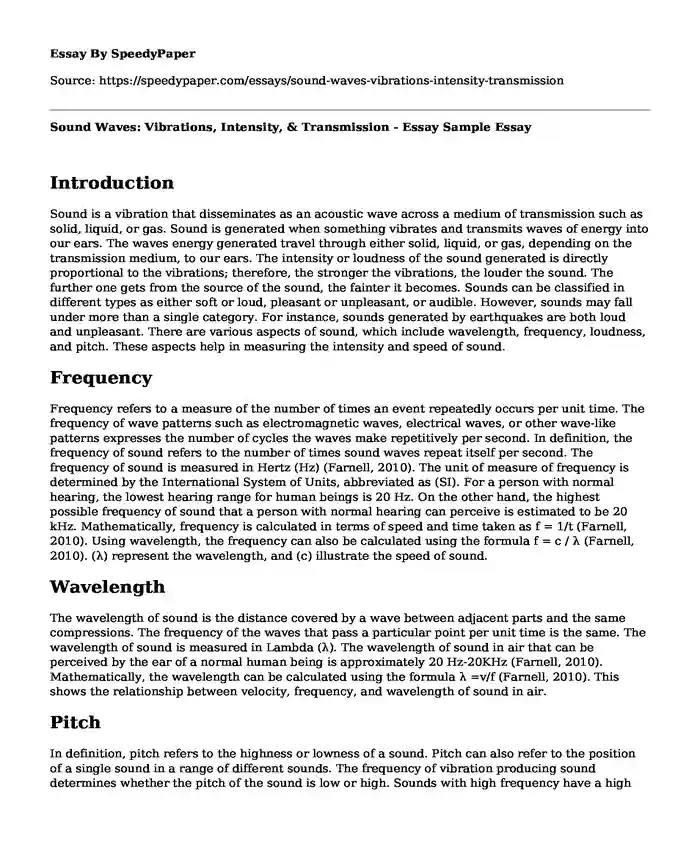Introduction
Sound is a vibration that disseminates as an acoustic wave across a medium of transmission such as solid, liquid, or gas. Sound is generated when something vibrates and transmits waves of energy into our ears. The waves energy generated travel through either solid, liquid, or gas, depending on the transmission medium, to our ears. The intensity or loudness of the sound generated is directly proportional to the vibrations; therefore, the stronger the vibrations, the louder the sound. The further one gets from the source of the sound, the fainter it becomes. Sounds can be classified in different types as either soft or loud, pleasant or unpleasant, or audible. However, sounds may fall under more than a single category. For instance, sounds generated by earthquakes are both loud and unpleasant. There are various aspects of sound, which include wavelength, frequency, loudness, and pitch. These aspects help in measuring the intensity and speed of sound.
Frequency
Frequency refers to a measure of the number of times an event repeatedly occurs per unit time. The frequency of wave patterns such as electromagnetic waves, electrical waves, or other wave-like patterns expresses the number of cycles the waves make repetitively per second. In definition, the frequency of sound refers to the number of times sound waves repeat itself per second. The frequency of sound is measured in Hertz (Hz) (Farnell, 2010). The unit of measure of frequency is determined by the International System of Units, abbreviated as (SI). For a person with normal hearing, the lowest hearing range for human beings is 20 Hz. On the other hand, the highest possible frequency of sound that a person with normal hearing can perceive is estimated to be 20 kHz. Mathematically, frequency is calculated in terms of speed and time taken as f = 1/t (Farnell, 2010). Using wavelength, the frequency can also be calculated using the formula f = c / λ (Farnell, 2010). (λ) represent the wavelength, and (c) illustrate the speed of sound.
Wavelength
The wavelength of sound is the distance covered by a wave between adjacent parts and the same compressions. The frequency of the waves that pass a particular point per unit time is the same. The wavelength of sound is measured in Lambda (λ). The wavelength of sound in air that can be perceived by the ear of a normal human being is approximately 20 Hz-20KHz (Farnell, 2010). Mathematically, the wavelength can be calculated using the formula λ =v/f (Farnell, 2010). This shows the relationship between velocity, frequency, and wavelength of sound in air.
Pitch
In definition, pitch refers to the highness or lowness of a sound. Pitch can also refer to the position of a single sound in a range of different sounds. The frequency of vibration producing sound determines whether the pitch of the sound is low or high. Sounds with high frequency have a high pitch, while sounds with low frequency have low pitch.
Loudness
The loudness of sound refers to how soft or loud a sound is to a listener. The intensity of sound waves determines the loudness of sound. Intensity refers to a measure of energy transmitted by sound waves. The unit of measure of sound intensity is the decibel, which is abbreviated as (dB). The amplitude of the sound causes the loudness of sound.
References
Farnell, A. (2010). Designing Sound. Mit Press.https://d1wqtxts1xzle7.cloudfront.net/50147825/Designing_Sound_-_Andy_Farnell.pdf?1478460409=&response-content-disposition=inline%3B+filename%3DDesigning_Sound.pdf&Expires=1599501896&Signature=RmtvvPwbdUMlQ5-y2qP0NCGv979sV3ImEJY~oek6Rf5wynyMRJF9cmHgq2FqT-~kRLdOT0iB9oV4-aIK1hZWBAg~IGBl81Ouo7w8jvIeZibzT8u14WRBVrOO2U7VqfSf1-PBUZ9Sgo48V1xbOCG753AWHFrfekneohFyiRnjIp~Np5-xJKQsRenEXE5kpyREM6uRnNjJysMKgN2Q-uKrbcA2C512NMcukTm1AXuvPTfAmalkNVLPs70hjIku1XAToO1Wn8mTAXGEtVm0ohRdJsjjFt8yDRibHoXMbh8kOV~d9~H6XvNTIF9zzjtTHw1m34uRV6forzVFHj0TSps1EA__&Key-Pair-Id=APKAJLOHF5GGSLRBV4ZA
Cite this page
Sound Waves: Vibrations, Intensity, & Transmission - Essay Sample. (2023, Nov 30). Retrieved from https://speedypaper.net/essays/sound-waves-vibrations-intensity-transmission
Request Removal
If you are the original author of this essay and no longer wish to have it published on the SpeedyPaper website, please click below to request its removal:
- Essay Example on a Cluster Differentiation Antigen Expressed on the Immune B Cell
- Digital Marketing - Notting Hill Carnival. Free Essay
- Free Essay Sample: Artificial Intelligence in the Modern World
- Free Essay: Misconception That Physical, Cognitive and Mental Decline Are Inevitable in Old Age
- Classical Conditioning: Pavlov & Stimulus-Response Theory - Essay Sample
- Essay Sample on Why Mathematics Appeals to My Composed and Explicit Personality
- James Madison: Seeking Balance of Power Through Mutual Relations - Paper Example
Popular categories





